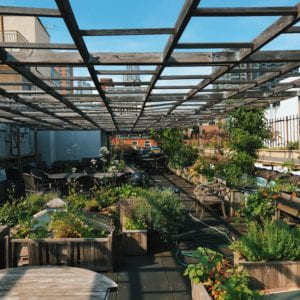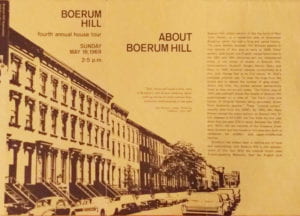
Rooftop of Right to the City’s office
Since Right to the City is a national organization and much of my research this summer deals more with addressing abstract concepts as defined by a multitude of local groups, it’s a little tricky for me to whittle the historical context of my work to a specific place. Instead, I’ll focus on Boerum Hill, the neighborhood where RTC’s national office is located, which is home to a rich history that’s incredibly relevant to the work RTC aims to address.
Originally called North Gowanus, the area was incredibly diverse for much of the 20th century up until the 1960s. As a result of white flight, North Gowanus was largely home to Puerto Rican residents and African Americans who had moved from the South in search of opportunity. The neighborhood was also noteworthy for its population of Mohawk ironworkers who would migrate down to the enclave (which they referred to as Little Caughnawaga) from the Kahnawake reservation near Quebec during the fall to help construct many of New York’s iconic skyscrapers (the Empire State Building and the United Nations Headquarters).
North Gowanus was also marked by poverty, crumbling infrastructure and, crucial to the development of Boerum Hill, blocks’ worth of 19th century brownstones with original fixtures which required little to no renovation and low rent. As a result, young white affluent families flocked to North Gowanus during the 60s, eager to make the neighborhood their own in similar fashion to Jane Jacobs and other members of the “back to the city” movement. But rather than working to integrate themselves within the existing North Gowanus community, the process of making themselves a home within North Gowanus, these self-proclaimed “pioneers” were more concerned with excluding their less-affluent neighbors from their new vision for the area, with one resident claiming that “We [the Boerum Hill Association] knew that [North Gowanus’ residents] simply did not have the same needs that we did.”
This process began with the neighborhood’s new name, proposed by new resident and future Boerum Hill Association president Helen Buckler to call back to the Dutch farming family that occupied the land during colonization, giving these “pioneers” the authentic foundation upon which they could create their new neighborhood. Next came the whitewashing of the district’s history. As referenced by real estate material from the time like “A History of Boerum Hill” by L.J. Davis, the Boerum Hill Association pulled from the area’s distant Dutch past, the erection of the brownstones in the 1800s, and the “rebirth” marked by the entry of these pioneers, overlooking the contributions made to North Gowanus by its black and Puerto Rican residents. As Philip Kasinitz mentions in his 1988 piece “The Gentrification of Boerum Hill: Neighborhood Change and Conflicts Over Definitions”, this intention to erase people of color from their historic communities didn’t go unnoticed by those in the area, with one Puerto Rican tenant organizer noting that Boerum Hill’s “pioneers” had “manufactured themselves a history; an Anglo-Saxon history-and in Brooklyn you have to go pretty far back to do that!”

Real estate pamphlet from 1969. Source: Brooklyn Historical Society, by way of https://www.brownstoner.com/history/boerum-hill-brooklyn-neighborhood-name-origins/
The pioneers’ aims to sever all ties with the surrounding community was realized in their successful campaign to give the brownstone blocks and some of the surrounding area landmark district status. In addition to giving Boerum Hill official boundaries visible to potential buyers, the move allowed its white affluent residents to access local political power they couldn’t attain as part of North Gowanus, where they had been a minority bloc, and diverted resources away from the surrounding area as a means of ensuring that their needs were more closely being addressed. I’ve found that the BHA’s unsuccessful proposal to restructure Brooklyn’s police districts and give Boerum Hill—one of Brooklyn’s smallest neighborhoods— its own precinct a perfect illustration of just how averse the pioneers were to inter-neighborhood accountability. The landmark district approval and closure of nearby bodegas, minority churches, and other community institutions, parked resistance from local Puerto Rican and white leftist groups.
Similar to other sites of displacement both within New York and beyond, Boerum Hill experienced another wave of gentrification during the 90s with the influx of the young white urban professional class. Again, we see residents expressing reluctance to anything that had the potential to penetrate the bubble they had created for themselves, especially around allowing agencies and clinics accountable to all of New York City’s residents to set up offices within their boundaries.
It goes without saying that Boerum Hill isn’t a unique story, which makes Right to the City’s work across the country with local groups to resist forces of gentrification all the more important, but that doesn’t mean that their presence within a site of ongoing displacement and marginalization is any less poetic. Boerum Hill remains a reminder of how improperly claiming one’s “right to the city”, to claim agency independent of that offered by governmental channels in shifting neighborhood mechanisms, can harm more than it helps.

This historical context is really helpful and, as you point out, even if the specifics are different (importantly so!) in different areas of the city and country, the larger social and economic mechanisms that create processes like labor migration and “back to the city” movements of young professionals are quite comparable. And while race is not only a function of class, the potent combination of the two in terms of housing rights often places poor people of color in a defensive position when it comes to “revitalization” and gentrification. Did you look at Suleiman Osman’s book The Invention of Brownstone Brooklyn? It offers a bit more along these lines. Your final paragraph is excellent — when we speak of a “right to the city,” it does seem like some people have more “rights” than others even if the organization itself (and Harvey) have aspirations to correct that.